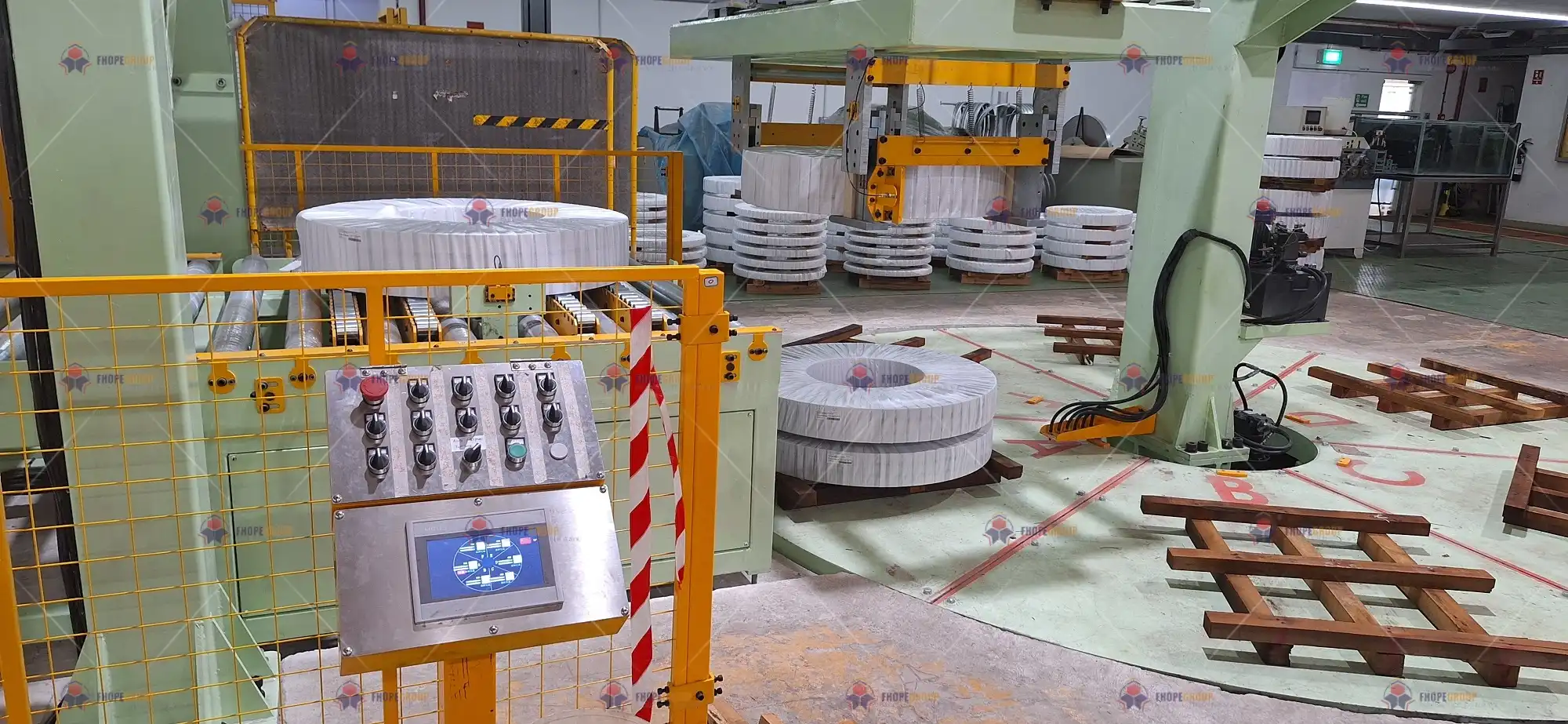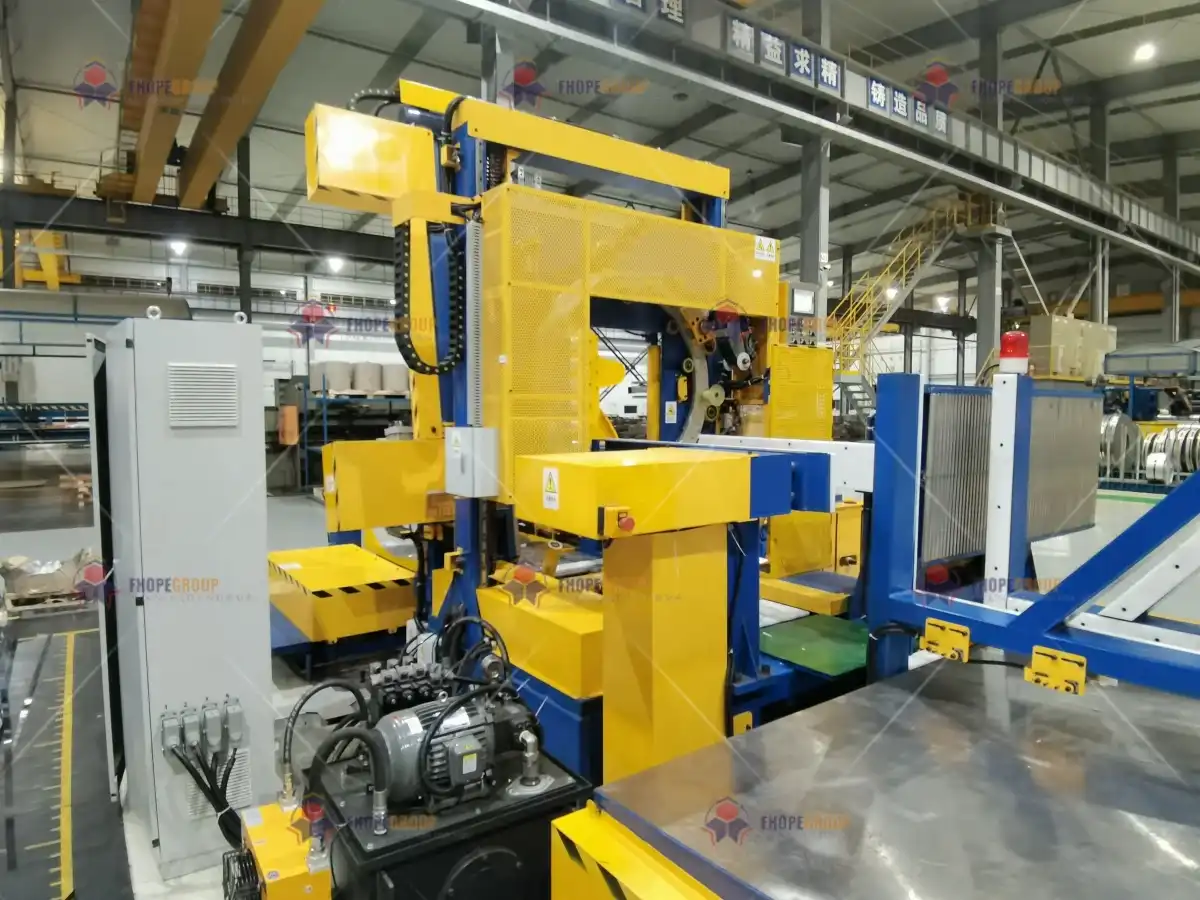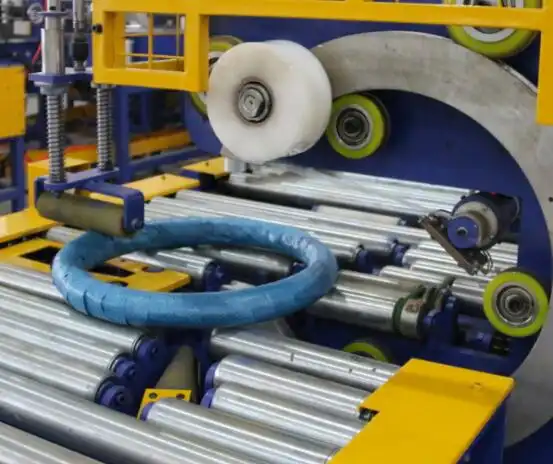Are you running a steel plant in Greece? You probably feel the constant pressure. The pressure to cut costs. The pressure to increase output. And the pressure to keep up with demanding customers. Often, the final step in your process, the coil packing line, becomes a major bottleneck. Manual wrapping is slow, inconsistent, and expensive. It feels like you're losing money and time at the very last stage, right before your product ships. This inefficiency chips away at your hard-earned profits and makes it difficult to compete in a tough market.
The best way to boost production efficiency in a Greek steel plant is by implementing a smart coil wrapping solution. This involves integrating automated wrapping machines with data-driven systems. These solutions reduce manual labor, optimize the use of wrapping materials, and provide consistent, high-quality packaging. This directly cuts operational costs, eliminates production bottlenecks, and protects your valuable steel coils from damage during transit.

I have walked in your shoes, though in a different part of the industry. I started as an engineer on the factory floor. I saw these challenges firsthand. Now, as the founder of SHJLPACK, I want to share what I've learned. This isn't just about selling machines. It's about finding the right total solution for your specific needs. Let's explore how a smart approach to coil wrapping can solve some of your biggest challenges and help you reach your goals. We will look at the real impact on your costs, the power of data, and how to choose equipment that will serve you for years to come.
How Can Automated Wrapping Lines Truly Reduce Your Operational Costs?
You look at your operational budget and see the numbers. Labor costs keep rising. The price of wrapping film and other consumables fluctuates, but always seems to go up. You might even have a line item for product damage, for coils that get rejected because of poor packaging. It’s frustrating because these are not small numbers. They add up, month after month, eating into your profit margins. You know there has to be a better way than simply throwing more manpower or more material at the problem.
An automated coil wrapping line directly reduces your operational costs in three key areas. It drastically cuts the need for manual labor on the packing line. It uses advanced technology to optimize the consumption of wrapping materials like stretch film. And it provides superior, consistent protection that minimizes costly product damage during handling and shipping.

Dive Deeper into Cost Reduction
When I started my career, I spent a lot of time on the factory floor, observing every step of the process. The packing area was always a hub of intense manual activity. It was also a source of hidden costs. Many managers focus on the big machines—the furnace, the rolling mill. But the savings you can find at the end of the line are just as real. Let's break down exactly where an automated system saves you money.
Labor Cost Reduction
This is the most obvious saving. A manual or semi-automatic process requires several operators per shift. They are responsible for moving coils, applying protective materials, and wrapping the product. This work is physically demanding and repetitive. An automated line can perform all these tasks with minimal human supervision. A single operator can often oversee an entire line that previously required four or five people. This isn't just about cutting salaries. It's about reallocating your skilled workforce to more valuable tasks, like quality control or machine maintenance, instead of manual labor.
Material Consumption Optimization
This is a more subtle, but equally important, saving. Smart wrapping machines are designed for efficiency. A key feature is the powered pre-stretch system for the stretch film. Our machines, for example, can achieve a pre-stretch ratio of over 300%. This means that for every 1 meter of film on the roll, the machine stretches it to 3 or 4 meters before applying it to the coil. This process not only uses significantly less film per coil but also makes the wrapping stronger and more stable. The machine applies the film with consistent tension and overlap every single time, something a human operator can never replicate. This precision eliminates the waste that comes from too much or too little material being applied.
Reduced Product Damage and Rejection
A steel coil is a high-value product. The last thing you want is for it to be damaged on its way to the customer. Inconsistent manual wrapping can leave edges exposed or create loose packages that shift during transport. This leads to scratches, dents, and corrosion. An automated system provides a full, tight, and uniform wrap. It protects every surface of the coil from moisture, dust, and physical impact. This means fewer customer complaints, fewer rejected shipments, and a stronger reputation for quality. The cost of one rejected shipment can often be more than the savings from an entire month of efficient material use.
| Cost Factor | Manual Wrapping Process | Automated Wrapping Line | Direct Impact |
|---|---|---|---|
| Labor | 3-5 operators per shift | 1 supervisor per line | 60-80% reduction in labor costs |
| Material (Film) | Inconsistent, manual stretching | Powered pre-stretch (>300%) | 50-70% reduction in film consumption |
| Package Quality | Variable, depends on operator | Uniform, consistent, and tight | Drastic reduction in transit damage |
| Throughput | 2-5 minutes per coil | 1-2 minutes per coil | Increased overall plant output |
Investing in automation is not an expense. It's a direct path to lowering your cost per ton and increasing your profitability.
What Role Does Data Integration Play in a Modern Coil Packing Line?
You have dashboards for your furnace and your rolling mill. You know your production figures, your energy consumption, and your uptime. But what about your packing line? For many plant managers, this final stage is a "black box." Coils go in, and wrapped coils come out. You don't have clear visibility into its performance. You can't see the small stops that add up to big delays. You don't know if the machine is running optimally. This lack of data makes it impossible to truly manage and improve efficiency. You are left reacting to problems instead of preventing them.
Data integration connects your coil packing line to your factory's central nervous system, like the Manufacturing Execution System (MES). It transforms the wrapping machine from a standalone piece of equipment into a smart, communicative asset. This gives you real-time production data, enables predictive maintenance alerts, and ensures full traceability for every coil you ship.

Dive Deeper into Data and Digitalization
When I built my first machines, they were strong and reliable. But they were also silent. They did their job, but they didn't talk. Today, that's not enough. A modern CEO like Javier, or any forward-thinking plant manager in Greece, needs information. You need to make decisions based on facts, not guesswork. This is why we now build our machines to be part of your digital ecosystem. This is a key part of our "total solution" philosophy. Let's look at what this means in practice.
Real-Time Monitoring and Visualization
A modern packing line is equipped with a PLC (Programmable Logic Controller) and an HMI (Human-Machine Interface). But we take it a step further. We ensure the PLC can communicate with your plant-wide systems using standard protocols like OPC UA or Profinet. What does this do for you? It means you can see the status of your packing line on the same screen where you monitor the rest of your plant. You can track Key Performance Indicators (KPIs) in real-time. You can see the number of coils wrapped per hour, the average cycle time, and any machine alarms. This visibility allows your production managers to spot bottlenecks instantly and take action.
Predictive Maintenance with IoT
Aging equipment is a major challenge. Machines fail, and unexpected downtime is extremely costly. Data helps you move from reactive maintenance (fixing things when they break) to predictive maintenance. We can embed IoT sensors in critical components of the wrapping machine. These can monitor things like motor vibration, bearing temperature, and pneumatic pressure. The system learns the normal operating parameters. When a sensor detects a small change, like a slight increase in motor temperature, it can send an alert to your maintenance team. This warning comes long before the component actually fails. Your team can then schedule maintenance during a planned shutdown, avoiding a catastrophic failure during peak production.
Traceability and Quality Control
Your customers demand quality and consistency. Data integration provides a digital "birth certificate" for every coil you wrap. When a coil arrives at the packing station, its ID is scanned. The packing line's PLC records all relevant data for that specific coil: the exact time it was wrapped, the wrapping program used, the amount of film consumed, and its final weight. This information is sent to your MES and linked to that coil's ID. If a customer ever has an issue, you can instantly pull up the complete history of how it was packaged. This level of traceability is essential for quality assurance and for serving demanding industries like automotive.
| Data Point Collected | System Component | Practical Application |
|---|---|---|
| Cycle Time per Coil | PLC & MES Integration | Identify efficiency losses and bottlenecks. |
| Motor Temperature/Vibration | IoT Sensors | Predict motor failure before it happens. |
| Film Consumption | PLC & Film Scale | Track material costs per coil, ensure efficiency. |
| Alarm/Error Codes | HMI & MES | Analyze recurring issues to find root causes. |
| Coil ID & Timestamp | Barcode Scanner & PLC | Provide full traceability for quality control. |
Data turns your packing line from a cost center into a strategic asset that provides valuable business intelligence.
How Do You Ensure the Reliability and Longevity of New Wrapping Equipment?
You’ve been burned before. You invested a significant amount of capital in a new piece of equipment from a supplier who promised the world. It worked well for the first six months. Then, the problems started. A small component failed. Then another. Getting service and spare parts was a nightmare. The machine that was supposed to increase your efficiency is now a constant source of downtime and frustration. This experience makes you cautious. You know that the real cost of a machine isn't just the purchase price; it's the total cost of ownership over its entire life.
You ensure long-term reliability by focusing on three things. First, insist on a robust mechanical design with heavy-duty construction. Second, verify that the supplier uses high-quality, internationally recognized components for all critical systems. Third, choose a supplier who sees themselves as a long-term partner, committed to providing excellent installation, training, and after-sales support.

Dive Deeper into Building for Reliability
As an engineer, this topic is personal to me. I believe a machine should be built to last. When I worked in another factory, I saw the consequences of cutting corners. I saw machines built with thin steel frames that would vibrate and wear out quickly. I saw control panels filled with no-name electrical components that failed constantly. When I started SHJLPACK, I made a promise to myself: we would build things the right way. For a business owner in Greece, or anywhere, reliability is not a luxury; it is the foundation of a profitable operation.
The Importance of Robust Mechanical Design
A coil wrapping machine in a steel mill operates in a tough environment. It handles heavy loads, 24 hours a day. The foundation of reliability is the machine's physical structure. The main frame must be constructed from thick, heavy-gauge steel, welded and reinforced to prevent any flexing or vibration under load. The turning ring, which is the heart of the wrapping process, must be precision-machined for smooth, balanced rotation. The conveyor rollers must be heavy-duty and equipped with high-quality bearings. We don't try to save a few dollars by using lighter materials. I know from experience that a strong frame is what allows a machine to run for 15 or 20 years, not just 5.
Sourcing High-Quality Components
A machine is only as reliable as its weakest component. This is why we are transparent about the brands we use. We build our control systems using PLCs and drives from globally recognized leaders like Siemens or Allen-Bradley. We use motors from SEW-Eurodrive. We use pneumatic components from Festo and sensors from Sick or Omron. Why does this matter? Because these are companies with a global reputation for quality and reliability. For a plant manager in Greece, it also means that spare parts and local technical support are readily available. You are not locked into a proprietary system from a single supplier. You are investing in a machine built with components you can trust and support locally.
A Partnership in Maintenance and Support
The sale does not end when the machine is delivered. That is just the beginning of the relationship. A true partner provides comprehensive support. This starts with professional installation and commissioning by experienced engineers who understand your production environment. It includes thorough training for your operators and maintenance staff, so they know how to run the machine efficiently and safely. And it continues with a clear plan for long-term support. This includes a recommended spare parts list, access to technical support, and options for preventative maintenance service visits. Our goal is to ensure your machine delivers maximum value for its entire lifespan.
| Component | Standard Choice | Why It Matters for Reliability |
|---|---|---|
| PLC/Control System | Siemens, Allen-Bradley | Global standard, high reliability, easy to integrate. |
| Motors/Gearboxes | SEW-Eurodrive | Excellent durability, energy efficiency, global support. |
| Pneumatics | Festo | Top-tier quality, long service life, low failure rate. |
| Sensors | Sick, Omron, Banner | High precision and durability for industrial environments. |
| Bearings | SKF, NSK | Reduces friction and wear on critical moving parts. |
Choosing a reliable machine is about looking beyond the price tag and investing in quality engineering and a strong partnership.
From Engineer to Owner: What Is the Most Important Lesson I've Learned About Equipment?
I want to share something personal. When I was a young engineer, I was obsessed with the technical details. I loved designing gears, calculating motor power, and writing PLC code. I believed that the "best" machine was the one with the most advanced features or the fastest speed. I measured success by technical specifications.
After I started my own factory and began working directly with clients—people like you, who have invested their lives and capital into their businesses—my perspective changed completely. I met owners who were worried about making payroll. I talked to plant managers who were under immense pressure to meet production targets. I saw how a single machine failure could cause a ripple effect of problems across an entire company.
That’s when I learned the most important lesson. A machine is not just a collection of steel, wires, and software. A machine is a promise.
It is a promise of reliability. It is a promise that it will do its job, day in and day out, so you can focus on running your business.
It is a promise of performance. It is a promise that it will help you save money, improve your quality, and make your operation more efficient.
Most importantly, it is a promise of partnership. It's a promise that when you invest your trust and your hard-earned money in us, we will be there to support you. We will be there to answer your calls, solve your problems, and help you succeed.
My journey from being an employee to an owner has taught me that business is about people. It’s about understanding challenges and providing real solutions. This is the philosophy behind SHJLPACK. We are not just selling coil wrappers. We are offering a total solution, built on a foundation of engineering excellence and a genuine commitment to your success. This is the promise I built my company on.

Conclusion
Smart wrapping solutions are your key to better efficiency, lower costs, and future growth. They transform your packing line from a bottleneck into a competitive advantage for your Greek steel plant.





